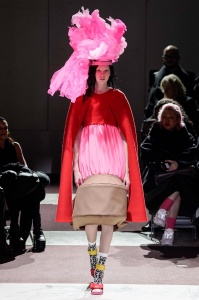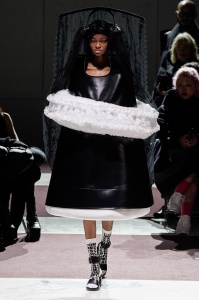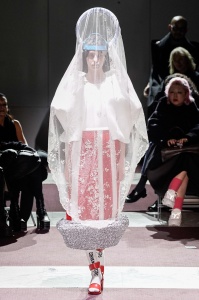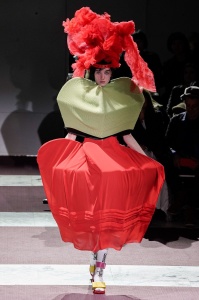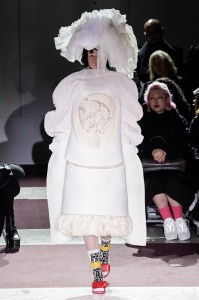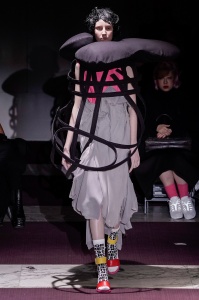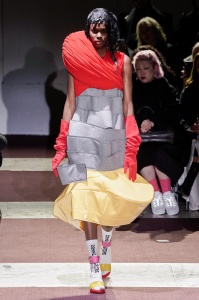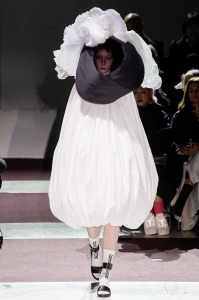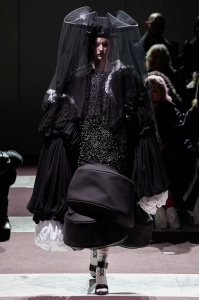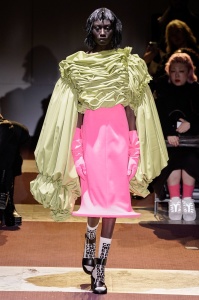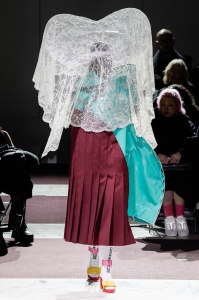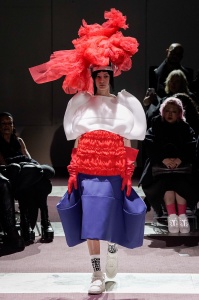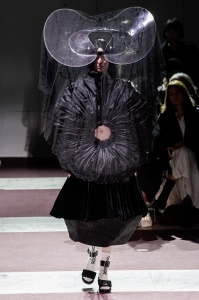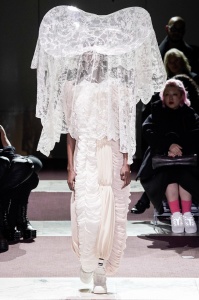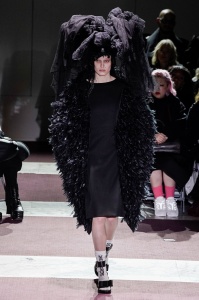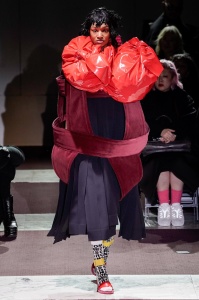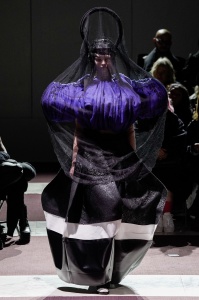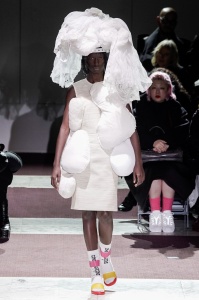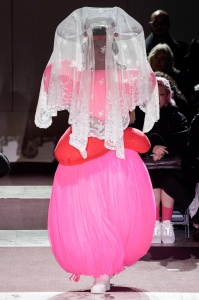You are using an out of date browser. It may not display this or other websites correctly.
You should upgrade or use an alternative browser.
You should upgrade or use an alternative browser.
Comme des Garçons F/W 2020.21 Paris
- Thread starter vogue28
- Start date
margielamike2004
Well-Known Member
- Joined
- May 2, 2005
- Messages
- 582
- Reaction score
- 149
There seems to be something bridal about this collection. It's a subject and theme that Rei has done in the past. Kinda reminds me of the Broken Brides collection.
margielamike2004
Well-Known Member
- Joined
- May 2, 2005
- Messages
- 582
- Reaction score
- 149
Broken Brides collection....Winter\Fall 2005.
jeanclaude
Well-Known Member
- Joined
- Feb 12, 2012
- Messages
- 4,682
- Reaction score
- 13,705
A "greatest hits" collection from Rei feels strange, because she is always pursuing the new...it seems she wasn´t inspired for this collection.
D
Deleted member 141309
Guest
Rei Kawakubo is a very sensitive topic in fashion, but I will dare to say that CdG is falling into irrelevance even in their paradigm of avant-garde and art approach. Yes, 3-5 years ago it was very into the zeitgeist, I know tons of people loving her to death and even they are drifting away from CdG. Something has to be done, it feels stale and mediocre. Almost like a Central Saint Martins graduate collection.
margielamike2004
Well-Known Member
- Joined
- May 2, 2005
- Messages
- 582
- Reaction score
- 149
The problem with CDG is.....Rei Kawakubo has been around for so long.....it can be difficult to understand where she's coming from, unless you've been aware of her for more than a decade. It's not easy rationalize and comprehend what she does. I'm not the most intelligent person in the world....but sometimes I'm not sure if a lot of people fully understand the definition of fashion....and what it is. My opinion is....fashion has a point of view. Weather a collection is wearable or practical.....isn't taken into consideration. For me....fashion is an art-form. Making something.....just for the sake of making something. It can be hideous ugly....or can be absolutely beautiful. It doesn't have to be flattering on the body....and it doesn't need to be marketable. The Celine collection is a great example. When looking at that collection....I will agree that it's considerably stylish.....and it's definitely very wearable....but it doesn't look like "fashion" to me....it just looks like clothes. There's nothing there to see....that isn't hard to understand. It looks great....but...there's nothing else to comprehend. Rei Kawakubo would consider Celine as "easy fashion.". As far as Celine....in regards to construction and how something is made....has all been done before. Nothing in that collection is made...in a unique way. Rei definitely repeats herself.....there's a common thread woven inbetween one collection to another.....but it never looks nostalgic. Nothing from Comme ever looks like something from the past......it's never retro. The entire Celine collection looks like it jumped out of the 1970s. Another problem with Comme is that it can be way too ahead of the curve....it can be too forward....and people simply aren't ready for it. Rei doesn't follow trends. Rei starts a trend....and everyone else eventually follows suit. Rei is....and always will be...a pioneer in regards to fashion. Most other designers out there...are just followers.
Phuel
Well-Known Member
- Joined
- Feb 18, 2010
- Messages
- 6,250
- Reaction score
- 11,275
^^^ You’re not wrong for digging this and I’m not wrong for thinking it’s lazy and trolling (WTF is with the slides and logo socks that turn these looks into a 6yo’s plushy costume for an Adventure Time class play…). And furthermore, Rei knows she can get away with it: Which is sort of offensive and insulting if I were a fan of hers for decades and is familiar with the complex, supreme and superbly visionary designs Comme is capable of.
It’s one thing to challenge and disturb fashiondom in a bide to innovate and progress the design vocabulary with new concepts and thoughtful ideation. This is not any of that; It’s silly and messy with no consideration for the human form and how it can work for it. It’s cumbersome, restrictive, imprisoning and more than anything, it doesn’t come from a place of creative thought that the best of Comme does.
It’s one thing to challenge and disturb fashiondom in a bide to innovate and progress the design vocabulary with new concepts and thoughtful ideation. This is not any of that; It’s silly and messy with no consideration for the human form and how it can work for it. It’s cumbersome, restrictive, imprisoning and more than anything, it doesn’t come from a place of creative thought that the best of Comme does.
Excellent points, margielamike. When it comes to something like Celine, the most I can say is that it inspires someone to buy, to consume, to put together an outfit. It’s a very passive engagement with fashion. When it comes to Comme des Garçons, this inspires someone to think, to create, to reconsider preconceived notions, whether that be the rejection of an aesthetic proposal (it’s kind of the point of Comme des Garçons to be seen as “ugly” by many) or the reconfiguration/evolution of one’s ideas about form, beauty, the relationship of clothes to the body. I mean, that’s why we have the avant-garde in the arts in the first place? Also, the disconnect between body and clothes has always been a thesis in Comme des Garçons. Clothes can be cumbersome, imprisoning, restrictive. Uh, yes, Rei has made this point again and again? The lumps and bumps collection for example? Comme des Garçons is not about creating desirability. It has never been advocating one way to see the relationship between the body and clothes.
Just looking at Comme des Garçons collections from ten years ago, you’d always be surprised at how those ideas have found their way into mainstream fashion today. The shapes, the cuts, the techniques, the construction. Even Galliano is basically doing footnotes. Brilliant footnotes, nonetheless. The legend of McQueen owes a great deal to the Comme des Garçons of the 80s and 90s.
Personally, why not enjoy fashion in all its iterations and vocabulary? One can admire something exquisitely beautiful from Dries Van Notes in the same way that one can still embrace something from Comme des Garçons, especially now that the consumption of beauty has been flattened to fit shorter attention spans and social media-friendly bubbles. That something desires to challenge ideas these days is quite frankly necessary.
Just looking at Comme des Garçons collections from ten years ago, you’d always be surprised at how those ideas have found their way into mainstream fashion today. The shapes, the cuts, the techniques, the construction. Even Galliano is basically doing footnotes. Brilliant footnotes, nonetheless. The legend of McQueen owes a great deal to the Comme des Garçons of the 80s and 90s.
Personally, why not enjoy fashion in all its iterations and vocabulary? One can admire something exquisitely beautiful from Dries Van Notes in the same way that one can still embrace something from Comme des Garçons, especially now that the consumption of beauty has been flattened to fit shorter attention spans and social media-friendly bubbles. That something desires to challenge ideas these days is quite frankly necessary.
Last edited:
D
Deleted member 141309
Guest
That is the problem with all the fashion. People need to respect Rei for the art she does and the boundaries she pushes. But people also have to respect Hedi for his Celine, because then people have timeless pieces to wear, and we don't all want to look like clowns or arts avant-garde figures. Fashion is very adaptive and transformative, there is no one or another. On the other hand, a very important issue, is knowing when to change things up, and for Comme des Garçons and Rei Kawakubo this time is now. We have people like Miuccia Prada herself, arguably one of the most legendary figures on par with Coco, Karl, Alexander, Rei, Hedi, John and etc., struggling to keep it up. People need to adapt, this is the reality. There always will be something or someone knew that shakes the fashion so hard that the change is just needed to stay relevant. We all know and admire Rei for her endless creativity, but let's not act like any designer can fall out of the flow of modernity and always stays in touch. And let's not measure fashion from Rei's or Vivienne's clowns to Hedi's and Maria Grazia's upscale mass market. It has way more dimensions than that. One can see art in the unexpectedness of avant-garde, and another sees art is the gorgeous embroidery of a generic looking Elie Saab couture gown.
Also, the idea that a 6 year old’s costume inspired by Adventure Time isn’t encompassed by our notions of beauty, wearability, design, well, let me just say that fashion isn’t only what you see on a runway... (By the way, aren’t the non sequiturs, anarchy, and general disregard for aesthetic boundaries of Adventure Time simply an extension of what Comme des Garçons has always done?)
I actually went to Dover Street today & had similar thoughts as above! The amount of collabs & borderline irrelevant product is a bit disappointing. The hypebeasts love it though & will continue to buy. Still feels like a treasure to see the vintage collections.
This is admittedly not a strong collection. I don’t think Rei has made as much of a powerful statement in fashion since her Met show. But I’m still going to put some faith in her because I think she’s simply trying to figure out a future direction for Comme des Garçons after the collections that came before the Met show. I mean, where do you go after basically dismantling, deconstructing, exploding everything that you know about fashion? I’ll give her some leeway as she navigates this late stage of her career.
dior_couture1245
Fat Karl
- Joined
- Jan 30, 2006
- Messages
- 9,225
- Reaction score
- 4,763
Irrelevant is the right word. I don’t care what “concept” drove this collection, these “sculptural” pieces don’t do anything anymore. I mean, she’s been doing these kinds of pieces for a decade practically. There’s nothing shocking or surprising about this. If she’s not interested in conventional clothes making anymore, why not just move on to actual sculpture? Fashion must have some connection to the body and to reality otherwise what exactly is the point? I’m not advocating for everything being commercial, but even the great conceptual and fantastical designers knew that there needed to be clothes on the catwalk that could have some function in the real world for a real woman. Otherwise it’s costume and I just don’t think it’s even classifiable as fashion anymore, frankly.
If she wanted to shock again or challenge us again, she’d do real clothes again.
If she wanted to shock again or challenge us again, she’d do real clothes again.
No one is really saying this can’t be sculpture? Or that it should be classified as “just” fashion? Why can’t it straddle both polarities? Personally I’m not interested in rigid, strict boundaries in any creative field. Fashion/sculpture is just as valid as, say, cinema/videogame, literature/graphic design, food/sculpture.
It also seems like many times there is an attempt to force Comme des Garçons into a paradigm it never claimed to belong to in the first place? Functionality, wearability, fashion in the strictest sense, etc. In a way it’s analogous to criticizing an Oulipo novel for lacking the psychological depth of something by Henry James.
But clearly these things are on the human body. They are being “worn” and the human body goes from point to point with these garments on. As something to be worn comfortably in the office, on the train, in “real” life, do these succeed? No. Were they designed with those intentions in the first place? No. Then again some would say the idea of “real” life is contestable nowadays, since many people live most of their lives “virtually”, and this collection can definitely “live” in this hybrid virtual/real world we are in.
I agree though that she should shock us and design something very sober.
It also seems like many times there is an attempt to force Comme des Garçons into a paradigm it never claimed to belong to in the first place? Functionality, wearability, fashion in the strictest sense, etc. In a way it’s analogous to criticizing an Oulipo novel for lacking the psychological depth of something by Henry James.
But clearly these things are on the human body. They are being “worn” and the human body goes from point to point with these garments on. As something to be worn comfortably in the office, on the train, in “real” life, do these succeed? No. Were they designed with those intentions in the first place? No. Then again some would say the idea of “real” life is contestable nowadays, since many people live most of their lives “virtually”, and this collection can definitely “live” in this hybrid virtual/real world we are in.
I agree though that she should shock us and design something very sober.
YohjiAddict
Well-Known Member
- Joined
- May 26, 2016
- Messages
- 3,655
- Reaction score
- 5,186
I don't know why but I have this morbid obsession with clothes for mourning and veiling of the face. This collection is everything I could've asked for in that regard and yet I do wish for some measure of reality in her shows. I don't think is really that impossible.
Her S/S 2019 show was actually really wearable to the point of resembling something she would've presented at the beggining of the career, so I'm not completely sure she's decided to forego any and all notions of clothing. It's like she'd rather not commit to just one thing, and can afford to dial back and forth at the moment.
My love for CdG has wavered before but she always comes back with something that restarts my obsession. Hope is not really lost for me.
Her S/S 2019 show was actually really wearable to the point of resembling something she would've presented at the beggining of the career, so I'm not completely sure she's decided to forego any and all notions of clothing. It's like she'd rather not commit to just one thing, and can afford to dial back and forth at the moment.
My love for CdG has wavered before but she always comes back with something that restarts my obsession. Hope is not really lost for me.
margielamike2004
Well-Known Member
- Joined
- May 2, 2005
- Messages
- 582
- Reaction score
- 149
When I saw CDG for the first time....back in the early 1980's....I honestly didn't like it. I couldn't understand why anyone would want to wear something so strange and so unusual. Furthwrmore....everything was practically black...and it didn't appeal to me. I'm sure many of you are aware of a particular sweater from Comme....back from the 80. It was incredibly boxy and square....it has holes or....for lack of a better word.....braid-work throughout the piece?? First of all...it looked sloppy...and it wasn't very flattering. I was raised on clothing brands such as Polo, Ralph Lauren....Esprit.....Benetton, etc. CDG was way too bizzare for me to aporeciate it....so I dismissed it. Basically.....I thought CDG was a joke and not something to be taken seriously. But...in some kinda strange way...I was also drawn to it. It seemed like a collection that had no rules...and it made me question my idea of what fashion is. Basically.....it made me think outside the box. I honestly don't like every CDG collection that I see (which includes this collection)....but I always appreciate them....and I'm always captivated. I will agree that I (and a lot of us)....are growing a bit tired of Rei and her repetitive concepts. As of late....it seems as though Rei is becoming very one-note. Another collection where nothing is practical.....another collection where wearability isn't taken into consideration. For me....Rei is very much like a catch-22....sometimes I love what she presents and sometimes I truly can't stand it. But, nonetheless....as I stated prior....I'm always captivated.
margielamike2004
Well-Known Member
- Joined
- May 2, 2005
- Messages
- 582
- Reaction score
- 149
You're right about those tacky socks and shoes. For the past several seasons....I've been very surprised to see the CDG logo in her collections. From Comme....that was typically something you would never see. Corporate logos...status bull-shite, etc. I understand the reasons why she's doing this....but it's unfortunate to see Rei selling out her integrity.^^^ You’re not wrong for digging this and I’m not wrong for thinking it’s lazy and trolling (WTF is with the slides and logo socks that turn these looks into a 6yo’s plushy costume for an Adventure Time class play…). And furthermore, Rei knows she can get away with it: Which is sort of offensive and insulting if I were a fan of hers for decades and is familiar with the complex, supreme and superbly visionary designs Comme is capable of.
It’s one thing to challenge and disturb fashiondom in a bide to innovate and progress the design vocabulary with new concepts and thoughtful ideation. This is not any of that; It’s silly and messy with no consideration for the human form and how it can work for it. It’s cumbersome, restrictive, imprisoning and more than anything, it doesn’t come from a place of creative thought that the best of Comme does.
margielamike2004
Well-Known Member
- Joined
- May 2, 2005
- Messages
- 582
- Reaction score
- 149
From what I've heard......sculpture is something that Martin Margiela has been doing....as of late.Irrelevant is the right word. I don’t care what “concept” drove this collection, these “sculptural” pieces don’t do anything anymore. I mean, she’s been doing these kinds of pieces for a decade practically. There’s nothing shocking or surprising about this. If she’s not interested in conventional clothes making anymore, why not just move on to actual sculpture? Fashion must have some connection to the body and to reality otherwise what exactly is the point? I’m not advocating for everything being commercial, but even the great conceptual and fantastical designers knew that there needed to be clothes on the catwalk that could have some function in the real world for a real woman. Otherwise it’s costume and I just don’t think it’s even classifiable as fashion anymore, frankly.
If she wanted to shock again or challenge us again, she’d do real clothes again.
Phuel
Well-Known Member
- Joined
- Feb 18, 2010
- Messages
- 6,250
- Reaction score
- 11,275
You're right about those tacky socks and shoes. For the past several seasons....I've been very surprised to see the CDG logo in her collections. From Comme....that was typically something you would never see. Corporate logos...status bull-shite, etc. I understand the reasons why she's doing this....but it's unfortunate to see Rei selling out her integrity.
To be frank, Comme as a brand isn’t that different from the other more commercial brands, Hedi’s Celiné being used as a contender here. I’d even say it’s more exploitive of its status as a coveted name as any other brand since there are numerous sub-labels of CdG debuting more than Jennifer Lopez debuts her perfumes. And all these sub-lines are as consumer-end basics of shirts, golf jackers and the most basic accessories as they come. So no need to put this label at some higher standing for integrity than a more commercial brand. It’s not a slight on Rei and her Comme universe of course, just a reality that she is as much of a businesswoman as anyone else that is successful in the industry. I don’t think less of her and her brand just because she’s hustling coats tees and kicks with her logo all over them— if that’s what pays so the mainline label can put out stunning creations that redefine what is high fashion. Just that stuff like these sloppy plushie Adventure Time characters doesn't cut it.
Similar Threads
- Replies
- 325
- Views
- 104K
- Replies
- 20
- Views
- 11K
- Replies
- 106
- Views
- 28K
Users who are viewing this thread
Total: 1 (members: 0, guests: 1)

